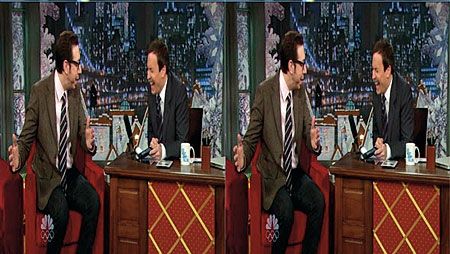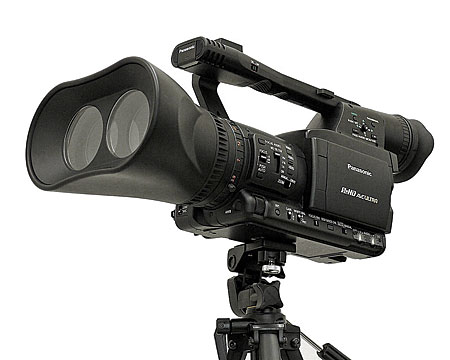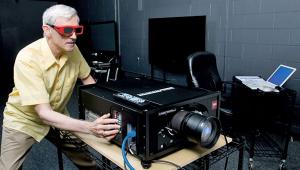3D: The Next Big Thing? Page 2
But it never disappeared completely. 3D was periodically resurrected after the 1955 fade-out, but each time it receded again into the movie mists.

Today we’re in the midst of another 3D craze, and all signs indicate that it may be the most durable. 3D productions now benefit from digital technology that wasn’t available in the past, both on the production and presentation sides. Many professionals also believe they have eliminated the problems that short-circuited earlier revivals.
New 3D films have proven to be so popular that the home video industry looked at the potential for 3D HDTV at home and asked, “Why not?” Of course, the big, unanswered question is whether or not the audience’s enthusiasm for 3D will last. The video industry is betting big bucks that it will.
Blu-ray to the Future
How will we get 3D at home? The most obvious and promising path is via a newly adopted 3D extension to the Blu-ray format.
Dedicated 3D Blu-ray players and 3D TVs, combined with 3D Blu-ray software, will provide uncompromised 3D HD performance, with a resolution of up to 1920 by 1080 for each eye. Based on what we know, a 3D Blu-ray Disc will include the data to produce a full-resolution 2D image, plus additional data—called the Dependent View—that includes 3D information. The player combines the 2D image and the Dependent View, and it decodes them into two separate images, one for the left eye and one for the right.
Instead of having two completely separate images on the disc itself, the supplementary 3D data is in the Dependent View. This saves considerable disc space. Nevertheless, 3D on Blu-ray will require up to 50 percent more data space than a 2D release. To make the most efficient use of the 50 gigabytes that are available on a dual-layered Blu-ray Disc, the MPEG4 Multiview Video Coding (MVC) 3D TV codec is the standard for all 3D Blu-ray releases. MPEG4-MVC is an extension to the ITU-T H.264 Advanced Video Coding (AVC) codec that’s used to encode many 2D Blu-ray Discs.

Sony and Panasonic have also recently developed a 67-GB Blu-ray Disc. We don’t know how this will serve the market for packaged 2D and 3D Blu-rays, but a 67-GB disc will certainly be a player in the recordable Blu-ray arena.
The TV can process and display the data representing the two fullresolution 3D images in a number of ways. The chosen method will be up to the set manufacturer. Based on what we saw at CES, the method that will likely dominate, at least at first, is called frame sequential. With this technique, the displayed image will use the following sequence: First frame, left eye; second frame, right eye; third frame, left eye; fourth frame, right eye, etc. Special shutter glasses alternately pass and block the light to each eye to prevent one eye from seeing the images meant for the other eye. The glasses use LCD elements to alternately pass and block the light, and an IR signal from the set appropriately triggers the LCD elements to maintain correct syncronization.

Each frame will likely flash more than once in each eye to eliminate flicker, just as today’s 2D sets do. (For example, 24-fps content would be unwatchable if each frame flashed only once.) This means 3D-compatible TVs must have a relatively high refresh rate. Most TVs can already operate at rates as high as 96 hertz, 120 Hz, 240 Hz, and even higher. That’s a start, but most current TVs will still remain incompatible with 3D because they need more than just a higher refresh rate. 3D TVs require new kinds of processing as well.
Although most current sets won’t play back 3D, Mitsubishi RPTVs are specified as 3D-ready. We always assumed that they wouldn’t play program material mastered to the new Blu-ray 3D standard since they don’t process and display 3D in the same way as we expect from flat-panel sets. However, at CES, Mitsubishi announced a converter box that it claims will let consumers play 3D Blu-ray Discs on its present, and possibly past, 3D RPTVs.
Besides the sequential frame approach, there are other ways in which a 3D TV can be designed to play back a 3D source. Some 3D TVs may employ polarized glasses rather than the much more expensive shutter glasses. Some may only display half the resolution from a 3D HD source. It isn’t fully clear how some of these techniques will operate, or how they will compare with full-resolution HD through shutter glasses. Speculation is risky at this point. We’ll check out these products and report on how they function as they appear. Don’t automatically assume that every time you see 3D on a 3D TV, it will be full high definition. Confirm this before you buy, and not just from a salesperson, who may know less about 3D HDTV than you do.














































